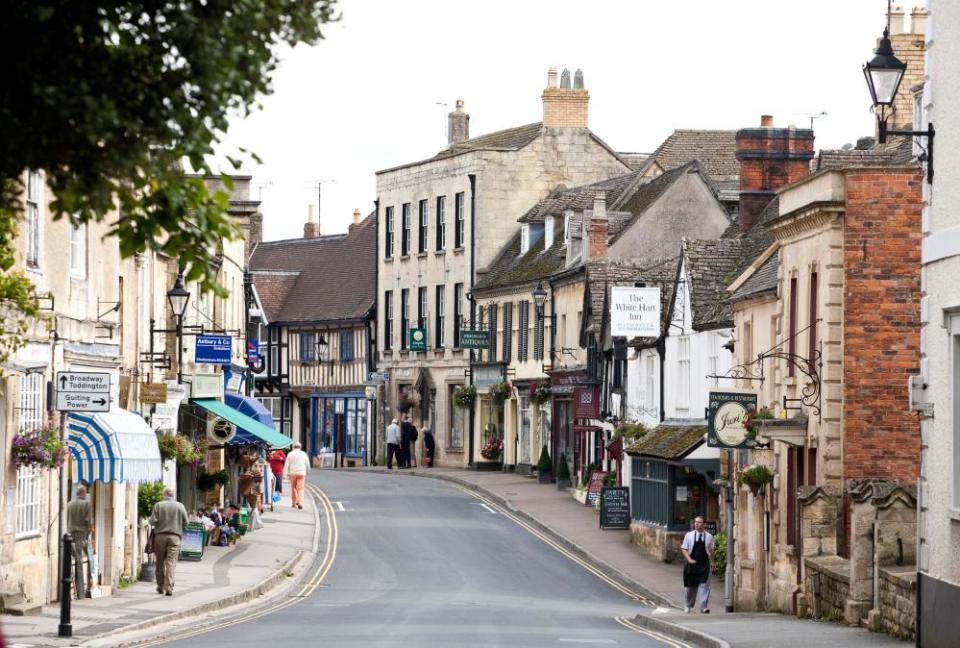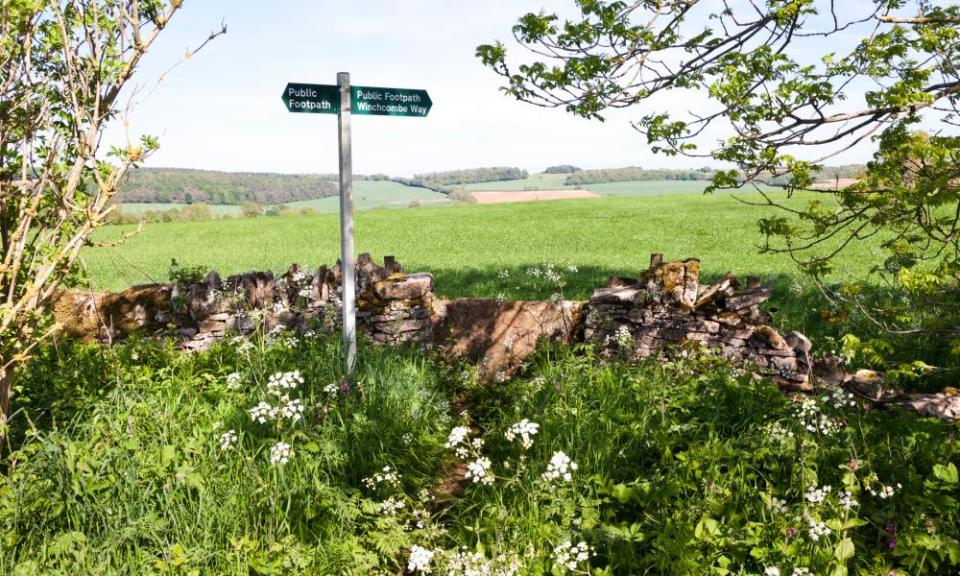Plenty of options all in one place: walking the Cotswolds from our village base

On a sunny day, on a hike in the Cotswold foothills, we stumble upon walking royalty. In the graveyard of Dumbleton’s Norman church, there he is: Patrick Leigh Fermor. A man who, in the 1930s, strode from Holland to the Bosphorus. Scanning his headstone’s Greek inscription in the oh-so-English countryside, we’re awed, humbled, envious. Though also aware that you don’t have to trek quite that far for a satisfying journey.
On our own five-day, car-free trip to Gloucestershire, my partner and I have walked almost 100 miles – and gotten nowhere. But we’ve found, among other things, a neolithic tomb, a wife of Henry VIII, a lot of birds and, now, a travel writing legend.
I like a linear long-distance walk, the sense of moving onwards. But with so many of us holidaying at home this year, finding available accommodation in a different place each night is trickier than ever. So to make life easier, we decided to hike to a self-catering cottage and do all our rambles from there. A good plan – as long as you pick the right base.
We opt for Winchcombe. It has an appealing amount of Cotswoldiness: honey stone houses, a pillowy-green setting, tearooms, antiques shops and an oversized church, pimpled with gargoyle-like grotesques. But it also feels like people live here. Among the 60-odd independents is a baker, butcher and deli, hardware store, post office and chemist. And while some Cotswold villages offer little more than cute photo ops, here there are things to do: four pubs, a museum and, on the outskirts, 15th-century Sudeley Castle (where Catherine Parr is buried).
We opt for Winchcombe. It has an appealing amount of Cotswoldiness
Plus, Winchcombe was one of the first towns to join Walkers Are Welcome, a community-led network of UK towns accredited as excellent hubs for hiking. This means footpaths are reliably maintained and trail information is readily available. Since 2009, an annual walking festival has been held here (1-3 October in 2021) and, 10 years ago, the Winchcombe Way was launched, a 42-mile, figure-of-eight route centred on the town.
To start, we trek to Winchcombe from Cheltenham train station; there is a direct bus, but we’re keen to start walking right away. We leave the genteel spa town for the looming escarpment and soon join the Cotswold Way national trail. This leads us over Cleeve Common, the Cotswolds’ highest point; a sign warns us not to “obstruct, annoy or molest” any golfers (we don’t); belted Galloways graze the scientifically interesting grassland; and a topograph points to the Malverns and Wales. Beyond, we pass the sleeping-giant hump of Belas Knap long barrow before finally reaching Winchcombe. Dinner at the old Lion Inn has been richly earned.

And collapsing into Thimble Cottage, our home for the break, is ideal. It’s a little limestone terraced bolthole only a few strides from the church and a couple more from the bakery, and we can drink our post-walk beers either on the garden patio or by the woodburner.
The following day, we buy chunky pasties from the bakery and take the bus north to the medieval wool town of Chipping Campden, with its glorious golden high street. This is the start of the Cotswold Way, which we follow back to Winchcombe, continuing our national trail wanderings in the opposite direction.
It’s a classic stretch, all buzzards and skylarks, lambs bleating behind limestone walls and blossom-dappled lanes. Our roaming may be slightly constricted by using one base but, standing by the hilltop folly of Broadway Tower, we can see far and wide – over (so they say) 16 counties on a clear day.

The Cotswold Way also takes us past Stanway, where there’s a fine Jacobean manor and a restored watermill. Both are shut when we first pass but, two days later, when we’re passing again – this time on the Winchcombe Way’s eastern loop – the mill is in action.
“Demand has rocketed since lockdown,” the miller tells us as we peek inside to watch the cogs and grindstones pummelling the locally grown grain, much as they have since at least 1291.
This retracing of our steps was unusual. Though we cover 100 miles, we only repeat a handful. Such is the abundance of footpaths around Winchcombe that there are always new routes to follow. For instance, the Winchcombe Way’s western loop treads totally different ground, leading us via wooded slopes and quiet villages off the traditional tourist trail. We climb up Langley Hill and drop to the thatched houses of Gretton. We rest on a bench at Alderton’s medieval St Margaret’s church, watching gravediggers at work. We meet Patrick Leigh Fermor at Dumbleton. At times, the toots of the
Gloucestershire Warwickshire Steam Railway resound through the valley; by chance, we reach Gotherington Halt just as a train puffs by.

Photograph: Stephen Dorey/Getty Images
This westerly route also leads up and over Nottingham Hill, site of an extensive iron age hillfort, before returning us to Cleeve Common – thankfully right by the golf clubhouse we clocked on day one. I’m in need of a cold drink, and had my mind set on stopping here. Sometimes it’s handy to pass the same way. But we’re soon breaking fresh ground once more, taking an alternative route across the common’s wilder reaches and back, again, to Winchcombe.
On our final day, we return to Cheltenham. It’s early when we set off, low sun sparkling on the dewy grass as we hike by Sudeley Castle, following the Windrush Way. After a while, this new trail veers east to bucolic Bourton-on-the-Water. Our plan is to peel off south, piecing together other paths, but suddenly it’s tempting to follow the Windrush instead. We could bimble to Bourton and ride the bus from there back to Cheltenham … Still plenty of options, all in one place.
• Winchcombe Welcomes Walkers details 20 varied, self-guided walks around the town. Thimble Cottage sleeps four, from £432 a week

 Yahoo Finance
Yahoo Finance 